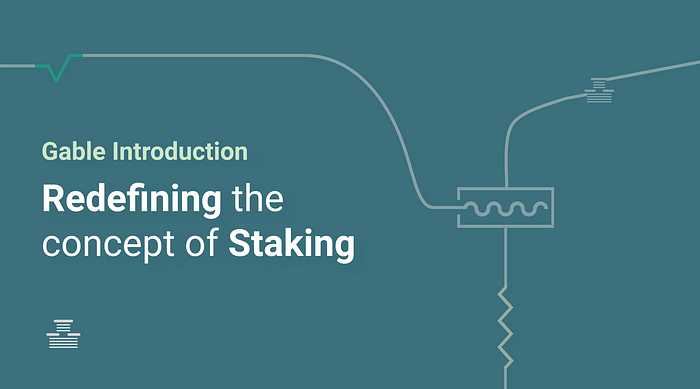
Staking forms the fundamental value proposition for any proof-of-stake network, providing a range of benefits like enhanced network security and passive asset earnings. At Gable, we strongly believe that staking offers even greater potential for value creation. Our protocols first version embodies this belief — breaking away from conventions and redefining the staking concept.
Gable operates as a liquidity market protocol, built on Radix DLT, offering lending products for borrowers and liquidity solutions for suppliers. Upon its initial release, the product offering will include two key features: (1) Liquidity collection through staking rewards as a liquidity solution, and (2) flash loans as a lending solution.
Liquidity collection via Staking Rewards
In traditional staking, users’ earned rewards are compounded on top of their initially staked assets. These accumulated rewards remain idle at their validator node until an unstaking event occurs. However, unlike the initial staked assets, the rewards are not subject to a lock-up period of approximately two weeks. As a result, users can access and utilize the staking rewards instantly, allowing them to generate additional value right away.
The mechanism operates as follows: A 100% fee is charged on staking, which results in the rewards to be released to the ‘owner’ of the validator node, rather than the validator node itself. The ‘owner’ can be anyone assigned the ‘owner’ role, such as an account address or a component address (like a smart contract). By granting the ‘owner’ role to a component, it opens the possibility of building an entire dApp around it. This concept serves a fundamental role behind Gable version 1.0.
Gable’s validator node applies a 100% fee on staking, releasing the staking rewards from the staked assets and depositing them into a liquidity pool. From this pool, lending products are issued, generating interest income. Suppliers, or stakers, receive 100% of these staking rewards (proportional to their stake) and also earn a share of the interest, compounding their return on staking rewards. This combination empowers stakers to increase their earnings on staking.
Collecting liquidity via staking rewards; a novel and innovative concept, unprecedented in the crypto space thus far.
Version 1.0 of the Gable Liquidity Protocol has been fundamentally built around the concept of collecting liquidity via staking rewards. The liquidity and lending solutions offered by the protocol are tailored to be compatible with each other and the network it operates on.
Liquidity vs. Lending Solution: A Marriage story
When it comes to collecting liquidity, various characteristics like durability, seasonality, magnitude, and timing of liquidity streams come into play. It’s essential to design the lending product(s) that utilize this liquidity in a way that aligns with these characteristics.
Collecting liquidity via staking rewards presents a highly durable approach due to the inherent ‘freeze’ feature of the network. Stakers must undergo a two-week lock-up period to unstake, introducing a barrier that enhances the durability of the liquidity pool.
Staking rewards are earned gradually over time, causing the liquidity pool to grow at a similar pace. Additional liquidity comes from interest earnings, enabling the pool to grow exponentially. This combination empowers the liquidity pool to strengthen and expand.
Liquidity Protocol and Network: Another Marriage Story
With Radix DLT’s upcoming Babylon launch, the ecosystem eagerly awaits the inclusion of programmability through smart contracts. As the Radix network is in its youthful state, it is likely to exhibit certain characteristics:
- Low Adoption and Network Activity
During the launch of smart contract functionality, the network’s user base will be limited, leading to limited adoption. This early stage might be accompanied by a lack of liquidity and price discrepancies across exchanges.
- Limited ecosystem
Radix’s ecosystem is still in development, and there might be a scarcity of well-audited and secure third-party applications and services. Key products like stablecoins, decentralized exchanges, and oracles could be immature or still under development.
Gable’s first release has been tailored to accommodate these characteristics by both avoiding associated risks and capitalizing on the opportunities they bring. In light of the infantile network, Gable deliberately avoids external dependencies until dApps mature and stabilize. Therefore, lending products that rely on stablecoin issuance or real-time price information from oracles have been excluded in the initial iteration. The team recognizes that relying on such services carries the risk of impacting Gable’s continuity, a risk we are not willing to take.
To address the lack of liquidity and price discrepancies across exchanges, Gable’s lending product offers instant liquidity, providing opportunities for arbitrage and liquidity enhancements. This feature aims to benefit the network and overcome these imperfections.
Flash loans as Lending Solution
Flash loans are a unique concept to the crypto space, allowing loans to be executed within a single transaction. Their exceptional characteristics offer endless opportunities for borrowers, traders, and investors throughout the industry.
One of the key features of flash loans is the smart contract’s ability to revert the loan if the agreed-upon terms are not met before the transaction is finalized. This unique property eliminates the need for collateral, making flash loans a safe and reliable concept for both borrowers and lenders. With no requirement for collateral, flash loans become an unsecured yet trustworthy option.
Moreover, the absence of collateral saves Gable from the necessity of implementing an oracle service for real-time price information on the collateral/borrowed token pair — a step we are hesitant to take at this stage.
In the short term, the majority of tokens will be trading against XRD — Radix’s native coin. As a result, issuing flash loans with XRD proves highly advantageous, effectively mitigating price discrepancies across exchanges and eliminating the necessity for stablecoin loans.
One drawback of collecting liquidity via staking rewards is the inability to adjust the available liquidity in response to changing market conditions. However, the instantaneous nature of flash loans minimizes the impact of such changes, effectively overcoming this limitation. Since liquidity never leaves the pool for more than one transaction, the pool remains consistently balanced over time, providing a flexible and dynamic solution.
At Gable, we firmly believe that success lies in creating synergy across products.
Our first release brings a combination of liquidity and lending solutions to Radix, tailored to complement each other and accommodate the network that supports the protocol.
Thank you for reading! If this post sparked your interest in Gable, please visit these channels for more information:
Visit Gable’s website: gable.finance
Follow Gable on X: x.com/Gable_Finance
